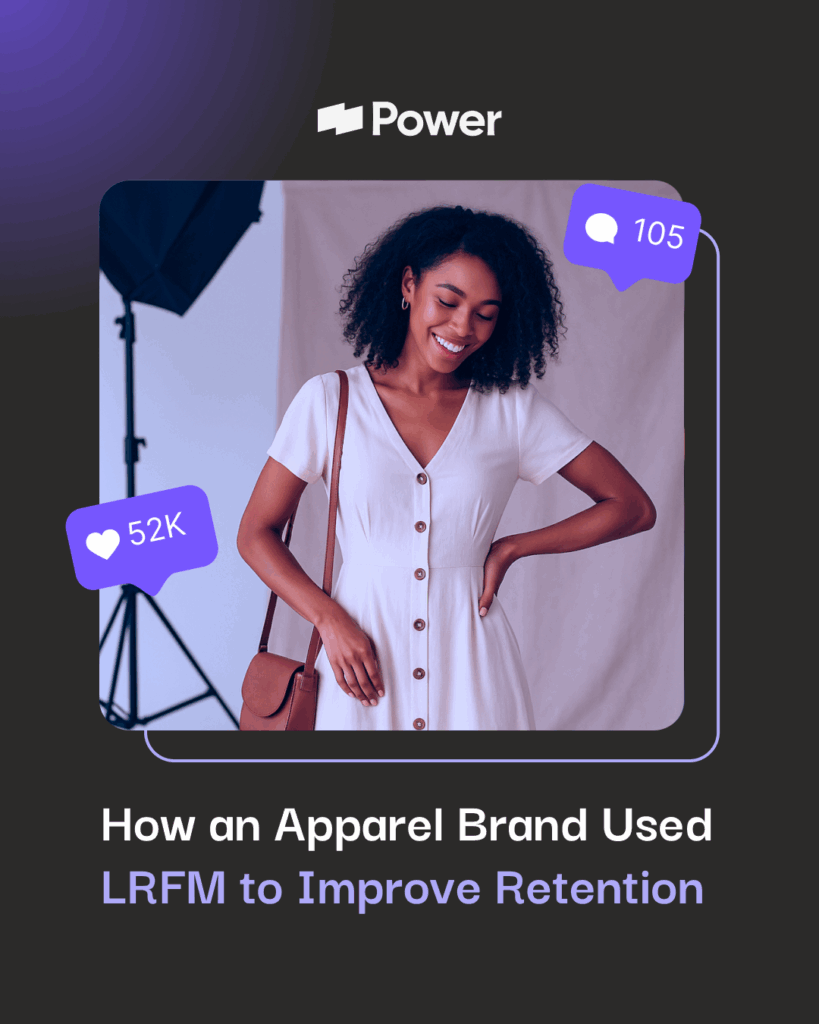TikTok vs Instagram marketing: which is better for your business?

- 1. Consideration #1: Target demographic
- 2.
- 3. Consideration #2: User engagement
- 4. Cosideration #3: Brand value
- 5. Consideration #4: The competition
- 6. Consideration #5: Brand identity
- 7. Consideration #6: Potential for virality
- 8. Consideration #7: Influencer marketing strategy
- 9. Leave your marketing strategy to the experts with Power Digital
Boutique companies and huge enterprises are well aware that social media marketing is one of the golden tickets to a thriving business. But with Instagram and TikTok—two of the largest social media titans—angling for consumers’ attention, where should brands invest their marketing budget?
In many cases, it may be advantageous to leverage both with the help of an IG or TikTok agency. When that’s not possible, it’s vital to determine where a company should focus the majority of its creativity and ad spend to make the biggest gains in lead generation, brand awareness, audience engagement and revenue.
Let’s unpack the TikTok vs. Instagram debate so that brands can use their resources wisely.
Consideration #1: Target demographic
TikTok may be the most downloaded social media app worldwide, but Instagram has substantially more active monthly users—that’s 1.47 billion to TikTok’s 1 billion, to be precise.1
In other words, even if a brand’s target audience spends the lion’s share of their time on TikTok, it’s also likely they swerve over to IG in between sessions. Nevertheless, there are some crucial distinctions to be made when it comes to the unique user demographics each social media platform primarily attracts.
TikTok usership
TikTok has garnered a reputation as the “It” place to be for Gen Z and Gen Alpha, who devour the endlessly scrollable, dopamine-laden short-form video content. And while TikTok undeniably got its start with younger users, more “mature” generations are starting to develop fluency in the platform.
Of those 1 billion active monthly users on TikTok, here’s how those age demos break down:2
- 25% – 10 to 19 years old
- 22.4% – 20 to 29 years old
- 21.7% – 30 to 39 years old
- 20.3% – 40 to 49 years old
- 11% – 50+
With respect to sex, female and female-identifying users tend to be more active on this social media app. As of 2022, 57% of TikTok users are self-identified women, and 40% are self-identified men.3
It’s important to note here that even though TikTok has younger users, attracting a young, hip audience is seldom bad for business. It’s actually quite the opposite—Gen Z is driving social commerce. Consider that 97% of users self-report using social media to decide where to put their dollars, whereas just 65% say they use social media as a place to find entertainment.4
The Instagram crowd
Instagram may not be the new kid on the block, but it still has a broad appeal that straddles generations of users. The platform draws a slightly older cluster of users, but only slightly; indeed, TikTok and Instagram have incredibly similar user demographics:5
- 7% – 13 to 17 years old
- 30% – 18 to 24 years old
- 33% – 25 to 34 years old
- 16% – 35 to 44 years old
- 8% – 45 to 54 years old
- 4% – 55 to 64 years old
- 2% – 65+
As for gender? IG’s usership is split almost exactly down the middle between men and women.
While the difference between each platform’s demographics is marginal, brands whose products or services target consumers under the age of 30 may be better off developing a TikTok SEO strategy. If a business calls to later generations, Instagram may be the winning choice.
Consideration #2: User engagement
Instagram may have considerably more monthly active users, but the amount of time consumers spend on a platform is crucial.
In this sense, TikTok is the unequivocal winner. Users spend an average of 46 minutes on the platform per day.6> On Instagram? That average boils down to roughly 30 minutes. And the more time a person scrolls through their feed, the greater a business’s chances of captivating user attention. With that being said, if you don’t know when to post on TikTok or Instagram properly, then user engagement can lessen.
Cosideration #3: Brand value
TikTok and Instagram are both visually-centered platforms, which is a boon for businesses that have products and services that are aesthetically pleasing.
That said, there are critical differences between the two platforms that ought to be considered before a business confirms where they should put their advertising dollars:
- TikTok – TikTok content is restricted to short-form videos. Today, content can last 10 minutes at maximum—a huge leap from their original length capped at 15 seconds7
For some brands, this format can feel restrictive. However, there are dozens of ways to get creative under these constraints. Whether it’s a sped-up skincare tutorial or a glimpse into how a jeweler sets a diamond from start to finish, there are infinite approaches brands can take to tailor their video content to the platform’s conventions.
- Instagram – Instagram offers long-form content, and arguably has broader, more diverse marketing applications for businesses. Still photos, IG stories, reels, carousels, and even uploaded webinars can all be leveraged to convey a brand’s image, mission and products
Whether a business is introducing a new product or promoting an upcoming sale, there are more opportunities to use different content formats—and with them, a greater variety of opportunities to test out marketing strategies.
Often, partnering with a digital marketing agency equipped to test out marketing strategies on both platforms is the best way to figure out which one resonates most with users. There are countless ways brands can deliver the value they pledge to give their customers, but it takes data, analytics and long-term testing to ascertain which routes are the most profitable.
Consideration #4: The competition
Knowing which peer businesses and competitors are crushing it online can further help businesses determine which platform is most beneficial for their goals.
A few brands making impressive use of TikTok include:8
- Crocs
- Planet Money
- Fenty Beauty
- Milkbar
- Dunkin’ (yes, as in Donuts)
- Chipotle
On Instagram, some of the leading brands are:9
- Recess
- Teva
- Madewell
- Tiffany & Co
- Glossier
- Chambard
- GoPro
A cursory comparison of the two lists indicates a distinction in brand sensibilities. Companies excelling on Instagram are a touch more sophisticated; some have products with higher price tags than those who are flourishing on TikTok.
Which brings us to our next point…
Consideration #5: Brand identity
Brand image is the key to conveying who the business is and what consumers can expect from their products. Given the centrality of polished photography on Instagram, it’s safe to say the platform has a more refined feel than its rough-around-the-edges counterpart TikTok.
Indeed, TikTok’s enormous appeal is because it’s off-the-cuff, authentic, fun, quirky and eminently relatable.
But not every brand fits this mold. More serious brands (like those in the finance or health sector) may be at odds with TikTok’s casual atmosphere—unless they can find even-keeled content creator-affiliates who users rely on to provide credible, trustworthy insights.
Put simply, consistency in a brand’s image and presentation is paramount, and adjusting to a platform’s conventions may confuse existing and prospective customers.10
Consideration #6: Potential for virality
Businesses may stand a higher chance of their content going viral on TikTok than Instagram, simply by the nature of the platforms:
- With Instagram’s algorithm, users are “fed” content by the people and businesses they follow
- TikTok provides users with curated content based on their interests and gives them the option to follow individual creators11
The takeaway? Brands have a higher chance of being seen by a wider audience and going viral on TikTok, independent of how many followers they have
But does “going viral” translate to more leads and conversions? Possibly. TikTok has helped launch countless small businesses into the stratosphere. But impressions or drawing enormous view numbers on any platform doesn’t always result in a follower, conversion or sales hike.12
Above all, no matter how clever a business’s viral post or ad may be, it must have relevance to the brand.
Consideration #7: Influencer marketing strategy
Influencer marketing has exploded as a marketing strategy to the tune of 800% since 2016.13 And while influencers are huge on Instagram, TikTok affiliate marketing is on the rise, especially with micro-influencers, which help businesses connect with super-specific consumer niches.
According to Forbes, TikTok is also:13
- Expanding in-app shoppability – The feature enables consumers to make purchases without leaving the app.
- Constructing fulfillment centers – While limited to the US, could these be a bonafide competitor of Amazon’s? Only time will tell (tick tock).
But will a growing crop of micro-influencers take root on Instagram? This remains to be seen. As of now, though, TikTok’s algorithm and the more relatable feel of the app bode well for niche businesses.
Leave your marketing strategy to the experts with Power Digital
Both IG and TikTok offer companies the opportunity to connect with their target audience profitably—but choosing which channel bodes best for your company’s unique marketing goals demands more than a coin flip.
Power Digital offers an analytics-first approach with nova, our platform for pooling, interpreting and applying the data brands need to thrive and prosper. In business, growth isn’t just about choosing “which” social media platform is best suited—it’s about identifying and forecasting trends so that you can make the most of any platform where you operate.
To find out what a full-service marketing strategy will look like for your brand, schedule a consultation with our digital marketing agency and start writing your company’s success story.
Sources:
- SEM Rush. 28 top social media platforms worldwide. https://www.semrush.com/blog/most-popular-social-media-platforms/
- Statista. U.S. Tiktok users by age 2021. https://www.statista.com/statistics/1095186/tiktok-us-users-age/
- Business of Apps. TikTok revenue and usage statistics (2022). https://www.businessofapps.com/data/tik-tok-statistics/
- Forbes. Gen Z and the rise of social commerce. https://www.forbes.com/sites/forbesagencycouncil/2021/05/17/gen-z-and-the-rise-of-social-commerce/?sh=198b458f251d
- Business of Apps. Instagram revenue and usage statistics (2022) https://www.businessofapps.com/data/instagram-statistics/
- Oberlo. 10 TikTok statistics. https://www.oberlo.com/blog/tiktok-statistics
- TechCrunch. TikTok expands max video length to 10 minutes, up from 3 minutes.https://techcrunch.com/2022/02/28/tiktok-expands-max-video-length-to-10-minutes-up-from-3-minutes/
- HubSpot. TikTok brands that are winning at marketing in 2022. https://blog.hubspot.com/marketing/brands-on-tiktok#why-brands-should-leverage-tiktok
- Social Media Strategies Summit Blog. Top 15 brands killing it on Instagram. https://blog.socialmediastrategiessummit.com/top-10-brands-killing-it-on-instagram/
- Forbes. Why consistency is the key to successful branding. https://www.forbes.com/sites/williamarruda/2016/12/13/why-consistency-is-the-key-to-successful-branding/?sh=27c718df7bbd
- Business Insider. TikTok has created viral dances and instant but it’s also helping small businesses cash in. https://www.businessinsider.com/going-viral-tiktok-help-small-businesses-launch-success-2021-6
- CNBC. How a business increased sales 14,000%: viral ads. https://www.cnbc.com/2014/05/02/how-a-business-increased-sales-14000-viral-ads.html
- Forbes. Influencer marketing: 2023 predictions. https://www.forbes.com/sites/forbesagencycouncil/2022/12/12/influencer-marketing-2023-predictions/?sh=391fc944b541
- CNET. TikTok is the most downloaded app worldwide in 2022 so far, analysts say. https://www.cnet.com/news/social-media/tiktok-is-the-most-downloaded-app-worldwide-in-2022-so-far-analyst-says/
Our Editorial Standards
Reviewed for Accuracy
Every piece is fact-checked for precision.
Up-to-Date Research
We reflect the latest trends and insights.
Credible References
Backed by trusted industry sources.
Actionable & Insight-Driven
Strategic takeaways for real results.






